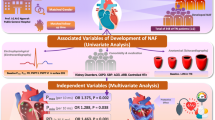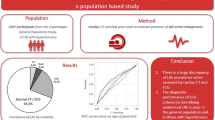Abstract
Cardiovascular disease is the leading cause of mortality in hypertensives, and patients with true resistant hypertension have an increased risk for premature cardiovascular events. Electrocardiography (ECG) has an essential role in the monitoring of hypertensive heart disease; however, little is known about the importance of ECG parameters in patients with resistant hypertension. We aimed to investigate whether fragmented QRS (fQRS) and frontal plane QRS-T angle, which are novel ECG parameters indicating myocardial damage, predict true resistant hypertension in patients with uncontrolled blood pressure. Four hundred six hypertensive patients with resistant hypertension were prospectively enrolled for the study. Patients were divided into two groups as ‘true resistant’ or ‘pseudo-resistant’ hypertensives and compared regarding the ECG parameters. While 73 (18%) patients had true resistant hypertension, 333 (82%) patients had pseudo-resistant hypertension. The frequency of fQRS (47.9% vs. 20.1%, p < 0.001) and average frontal plane QRS-T angle (93.0° ± 19.7° vs. 53.8° ± 10.2°, p < 0.001) were significantly higher in patients with true resistant hypertension compared to those with pseudo-resistant hypertension. Also, fQRS in anterior leads was significantly more frequent in patients with true resistant hypertension (57.1% vs. 23.8%, p < 0.001). Moreover, ROC curve analysis demonstrated that an increased frontal plane QRS-T angle > 90.75° predicted true resistant hypertension with a sensitivity 96% and specificity 61% (AUC:0.874, p < 0.001). Furthermore, multivariate analysis demonstrated that fQRS in anterior leads (OR: 1.251, 95% CI: 1.174–1.778, p = 0.002) and frontal plane QRS-T angle (OR: 1.388, 95% CI: 1.073–1.912, p < 0.001) were independent predictors of true resistant hypertension. In conclusion, fQRS and frontal plane QRS-T angle may be useful to predict true resistant hypertension in patients with uncontrolled blood pressure.
This is a preview of subscription content, access via your institution
Access options
Subscribe to this journal
Receive 12 digital issues and online access to articles
$119.00 per year
only $9.92 per issue
Buy this article
- Purchase on Springer Link
- Instant access to full article PDF
Prices may be subject to local taxes which are calculated during checkout


Similar content being viewed by others
References
Flint AC, Conell C, Ren X, Banki NM, Chan SL, Rao VA, et al. Effect of systolic and diastolic blood pressure on cardiovascular outcomes. N Engl J Med. 2019;381:243–51.
Prisant LM. Hypertensive heart disease. J Clin Hypertens (Greenwich). 2005;7:231–8.
Williams B, Mancia G, Spiering W, Rosei EA, Azizi M, Burnier M, et al. ESC/ESH Guidelines for the management of arterial hypertension. Eur Heart J. 2018;2018:3021–104.
Lehtonen AO, Puukka P, Varis J, Porthan K, Tikkanen JT, Nieminen MS, et al. Prevalence and prognosis of ECG abnormalities in normotensive and hypertensive individuals. J Hypertens. 2016;34:959–66.
Bacharova L, Schocken D, Estes EH, Strauss D. The role of ECG in the diagnosis of left ventricular hypertrophy. Curr Cardiol Rev. 2014;10:257–61.
Bacharova L, Estes EH. Left ventricular hypertrophy by the surface ECG. J Electrocardiol. 2017;50:906–8.
Judd E, Calhoun DA. Apparent and true resistant hypertension: definition, prevalence and outcomes. J Hum Hypertens. 2014;28:463–8.
Daugherty SL, Powers JD, Magid DJ, Tavel HM, Masoudi FA, Margolis KL, et al. Incidence and prognosis of resistant hypertension in hypertensive patients. Circulation. 2012;125:1635–42.
Pietrasik G, Zareba W. QRS fragmentation: diagnostic and prognostic significance. Cardiol J. 2012;19:114–21.
Jain R, Singh R, Yamini S, Das MK. Fragmented ECG as a risk marker in cardiovascular diseases. Curr Cardiol Rev. 2014;10:277–86.
Macfarlane PW. The frontal plane QRS-T angle. Europace. 2012;14:773–5.
Oehler A, Feldman T, Henrikson CA, Tereshchenko LG. QRS‐T angle: a review. Ann Noninvasive Electrocardiol. 2014;19:534–42.
Das MK, Zipes DP. Fragmented QRS: a predictor of mortality and sudden cardiac death. Heart Rhythm. 2009;6(3 Suppl):S8–14.
Aro AA, Huikuri HV, Tikkanen JT, Junttila MJ, Rissanen HA, Reunanen A, et al. QRS-T angle as a predictor of sudden cardiac death in a middle-aged general population. Europace. 2012;14:872–6.
Bekar L, Katar M, Yetim M, Çelik O, Kilci H, Önalan O. Fragmented QRS complexes are a marker of myocardial fibrosis in hypertensive heart disease. Turk Kardiyol Dern Ars. 2016;44:554–60.
Tanriverdi Z, Eyuboglu M, Bingol Tanriverdi T, Nurdag A, Demirbag R. The relationship between fragmented QRS and non-dipper status in hypertensive patients without left ventricular hypertrophy. Clin Exp Hypertens. 2017;39:680–4.
Tanriverdi Z, Unal B, Eyuboglu M, Bingol Tanriverdi T, Nurdag A, Demirbag R. The importance of frontal QRS-T angle for predicting non-dipper status in hypertensive patients without left ventricular hypertrophy. Clin Exp Hypertens. 2018;40:318–23.
American Diabetes Association. 2. Classification and Diagnosis of Diabetes: Standards of Medical Care in Diabetes-2020. Diabetes Care. 2020;43(Suppl 1):S14–S31.
Levey AS, Bosch JP, Lewis JB, Greene T, Rogers N, Roth D. A more accurate method to estimate glomerular filtration rate from serum creatinine: a new prediction equation. Modification of Diet in Renal Disease Study Group. Ann Intern Med. 1999;130:461–70.
Goldenberg I, Moss AJ, Zareba W. QT interval: how to measure it and what is “normal”. J Cardiovasc Electrophysiol. 2006;17:333–6.
Das MK, Khan B, Jacob S, Kumar A, Mahenthiran J. Significance of a fragmented QRS complex versus a Q wave in patients with coronary artery disease. Circulation. 2006;113:2495–501.
Calhoun DA, Jones D, Textor S, Goff DC, Murphy TP, Toto RD, et al. Resistant hypertension: diagnosis, evaluation, and treatment: a scientific statement from the American Heart Association Professional Education Committee of the Council for High Blood Pressure Research. Circulation. 2008;117:e510–26.
Kaczmarski KR, Sozio SM, Chen J, Sang Y, Shafi T. Resistant hypertension and cardiovascular disease mortality in the US: results from the National Health and Nutrition Examination Survey (NHANES). BMC Nephrol. 2019;20:138.
Díez J. Mechanisms of cardiac fibrosis in hypertension. J Clin Hypertens (Greenwich). 2007;9:546–50.
Salles GF, Cardoso CRL, Leocadio SM, Muxfeldt ES. Recent ventricular repolarization markers in resistant hypertension: are they different from the traditional QT interval? Am J Hypertens. 2008;21:47–53.
Salles G, Cardoso C, Nogueira AR, Bloch K, Muxfeldt E. Importance of the electrocardiographic strain pattern in patients with resistant hypertension. Hypertension. 2006;48:437–42.
Salles GF, Cardoso CRL, Muxfeldt ES. Prognostic value of ventricular repolarization prolongation in resistant hypertension: a prospective cohort study. J Hypertens. 2009;27:1094–101.
Eyuboglu M. Fragmented QRS as a marker of myocardial fibrosis in hypertension: a systematic review. Curr Hypertens Rep. 2019;21:73.
Eyuboglu M, Karabag Y, Karakoyun S, Senarslan O, Tanriverdi Z, Akdeniz B. Usefulness of fragmented QRS in hypertensive patients in the absence of left ventricular hypertrophy. J Clin Hypertens (Greenwich). 2017;19:861–5.
Eyuboglu M, Kucuk U, Senarslan O, Akdeniz B. Comparison of the presence of fragmented QRS complexes in the inferior versus the anterior leads for predicting coronary artery disease severity. Rev Port Cardiol. 2017;36:89–93.
Eyuboglu M. Characteristics of circadian blood pressure pattern of hypertensive patients according to localization of fragmented QRS on electrocardiography. High Blood Press Cardiovasc Prev. 2021;28:57–62.
May O, Graversen CB, Johansen MO, Arildsen H. A large frontal QRS-T angle is a strong predictor of the long-term risk of myocardial infarction and all-cause mortality in the diabetic population. J Diabetes Complications. 2017;31:551–5.
Dilaveris P, Gialafos E, Pantazis A, Synetos A, Triposkiadis F, Gialafos J. The spatial QRS-T angle as a marker of ventricular repolarisation in hypertension. J Hum Hypertens. 2001;15:63–70.
Acknowledgements
This article is an original article and it has not been published or submitted for publication elsewhere, in whole or in part, before submission to journal.
Author information
Authors and Affiliations
Corresponding author
Ethics declarations
Conflict of interest
The authors declare no competing interests.
Additional information
Publisher’s note Springer Nature remains neutral with regard to jurisdictional claims in published maps and institutional affiliations.
Rights and permissions
About this article
Cite this article
Eyuboglu, M., Acikel, B. Electrocardiographic differences in patients with true and pseudo-resistant hypertension. J Hum Hypertens 36, 622–628 (2022). https://doi.org/10.1038/s41371-021-00559-8
Received:
Revised:
Accepted:
Published:
Issue Date:
DOI: https://doi.org/10.1038/s41371-021-00559-8



